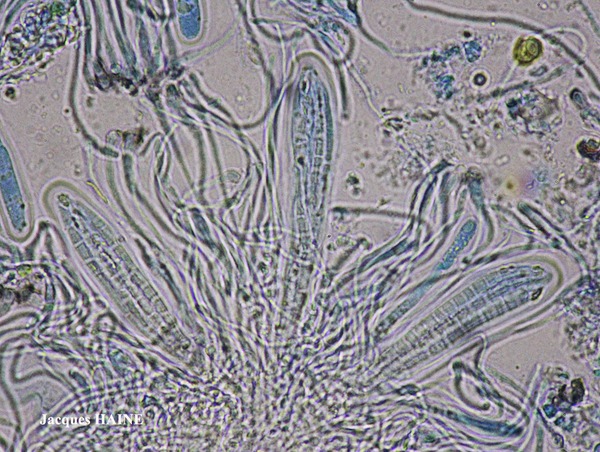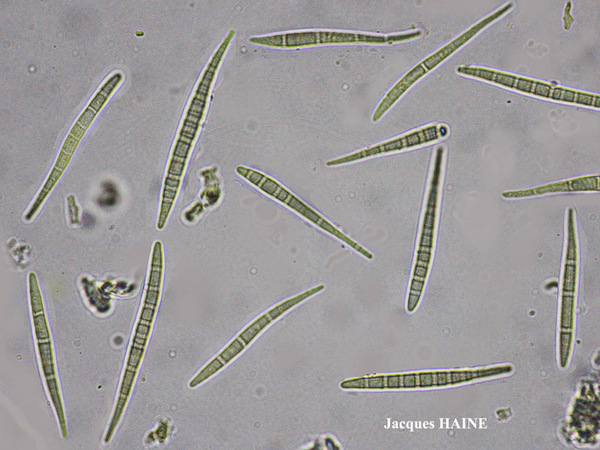Bacidia laurocerasi (Duby) Zahlbr.
Vain. ex Zahlbr., Cat. Lich. Univ., 4: 213, 1926. Basionym: Patellaria laurocerasi Delise ex Duby - Bot. Gall., 2: 653, 1830.
Synonyms: Bacidia atrogrisea (Delise) Körb.; Bacidia elevata Körb.; Bacidia endoleuca auct. non (Nyl.) J. Kickx f.; Bacidia subacerina subsp. laurocerasi (Duby) Vain.; Bacidia subacerina Vain.; Bacidia violacea (Arnold) Arnold non "(Crouan) Arnold"; Biatora atrogrisea Delise
Distribution: N - Frl, Ven (Thor & Nascimbene 2007, Nascimbene & al. 2013b), TAA (Nascimbene & al. 2007b), Lomb, Lig (E.C.I. 424: LD-1186694). C - Tosc, Umb (Ravera 2000, Ravera & al. 2006), Laz (Ravera 2006c), Mol (Ravera & Genovesi 2010, Ravera & al. 2010), Sar (Loi & al. 2000, Zedda 2002, 2002b, Rizzi & al. 2011, Cossu 2013, Neuwirth 2018, Di Nuzzo & al. 2022). S - Camp (Ricciardi & al. 2000), Cal (Puntillo 1996, Sérusiaux 1998), Si (Nimis & al. 1994, Ottonello & Puntillo 2009).
Description: Thallus crustose, episubstratic, continuous to rimose-areolate, grey to grey-green, sometimes delimited by a dark prothallus. Apothecia lecideine, (0.5-)0.5-0.8(-1.1) mm across, with a convex, usually epruinose, dark purple-brown to black, often mottled disc, and a concolorous or slightly paler, smooth, persistent or rarely excluded proper margin. Proper exciple 45-120 µm wide, without crystals or rarely with radiating clusters of crystals, brown or red-brown in upper and outer parts, pale yellow to colourless within, the pigmented parts K+ purplish; epithecium brown to black-brown, K+ purplish N+ orange-red, the pigment dissolved in the gelatinous matrix or as granules between apices of paraphyses; hymenium colourless or with brown vertical streaks, 75-115 µm high; paraphyses 0.8-1.6 µm thick at mid-level, the apical cells not swollen to clavate, (1.2-)2-3(-4) µm wide; hypothecium colourless or pale yellow. Asci 8-spored, clavate to cylindrical-clavate, the apical dome K/I+ dark blue with a pale, conical-pointed apical cushion (axial mass), the wall K/I-, but the thin outer gel K/I+ blue, Bacidia-type. Ascospores (2-)4-12-septate, hyaline, needle-like, straight to slightly curved, (32-)36-67(-73) x (2.5-)3-4(-4.3) µm. Pycnidia partly or entirely immersed, dark in uppermost part. Conidia simple, thread-like, curved, 5-10 x c. 1 µm. Photobiont chlorococcoid. Spot tests: thallus K- or rarely K+ yellowish, C-, KC-, P-. Chemistry: thallus without lichen substances or with traces of atranorin; epithecium, rim of proper exciple, and pycnidial wall with the Laurocerasi-brown pigment; hypothecium and inner part of proper exciple with the Rubella-orange pigment.Note: a humid subtropical to Mediterranean-Atlantic lichen found on smooth bark of broad-leaved trees in open humid forests; most frequent in Tyrrhenian Italy. According to Ekman (in litt.) the species might have been confused with B. heterochroa in the past (see note to B. heterochroa).
Growth form: Crustose
Substrata: bark
Photobiont: green algae other than Trentepohlia
Reproductive strategy: mainly sexual
Most common in areas with a humid-warm climate (e.g. most of Tyrrenian Italy)
Commonnes-rarity: (info)
Alpine belt: absent
Subalpine belt: absent
Oromediterranean belt: absent
Montane belt: rather rare
Submediterranean belt: very rare
Padanian area: absent
Humid submediterranean belt: rather rare
Humid mediterranean belt: rare
Dry mediterranean belt: absent

Predictive model
Herbarium samples
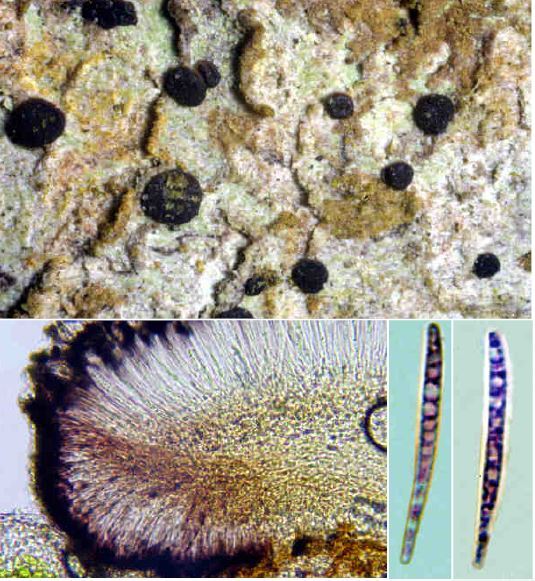

Felix Schumm – CC BY-SA 4.0
Image from: F. Schumm (2008) - Flechten Madeiras, der Kanaren und Azoren. Beck, OHG - ISBN: 978-3-00-023700-3
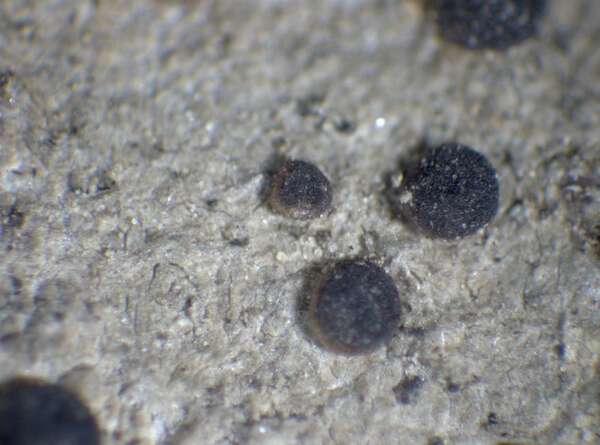

P.L. Nimis; Owner: Department of Life Sciences, University of Trieste
Herbarium: TSB (5247)
2001/11/22
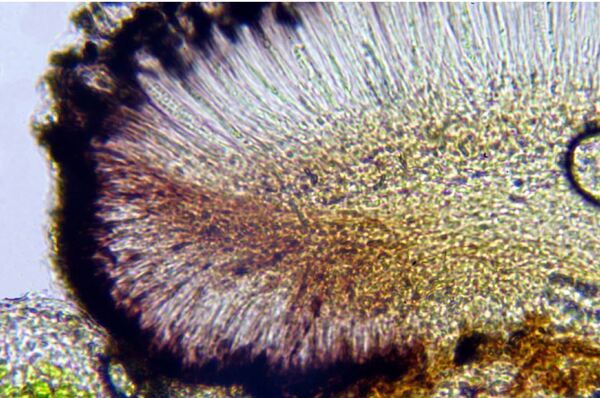

Felix Schumm - CC BY-SA 4.0
Image from: F. Schumm (2008) - Flechten Madeiras, der Kanaren und Azoren. Beck, OHG - ISBN: 978-3-00-023700-3
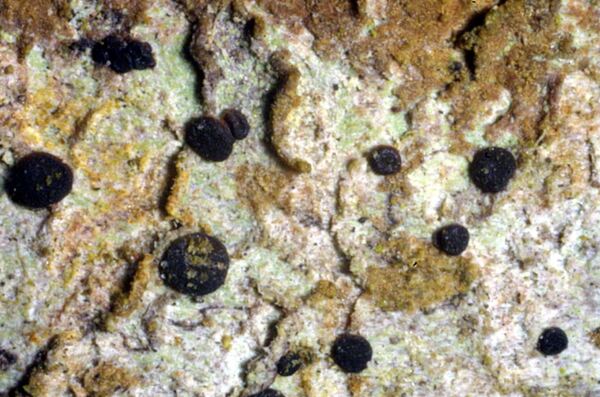

Felix Schumm - CC BY-SA 4.0
Image from: F. Schumm (2008) - Flechten Madeiras, der Kanaren und Azoren. Beck, OHG - ISBN: 978-3-00-023700-3
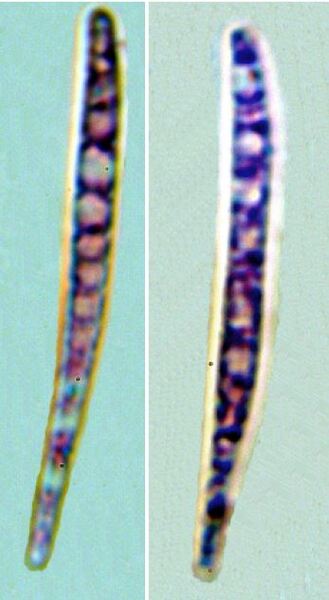

Felix Schumm - CC BY-SA 4.0
Image from: F. Schumm (2008) - Flechten Madeiras, der Kanaren und Azoren. Beck, OHG - ISBN: 978-3-00-023700-3
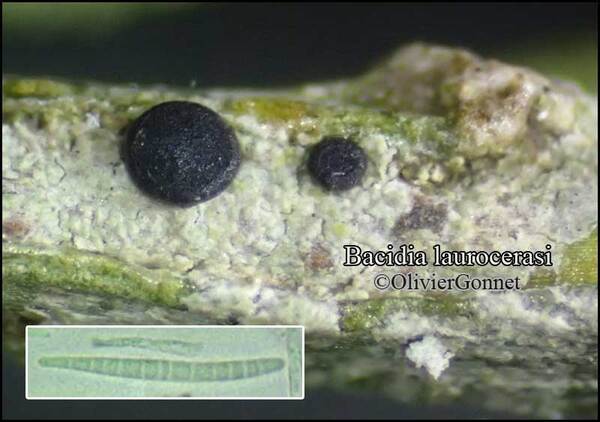
Courtesy: Olivier et Danièle Gonnet - Source: https://www.afl-lichenologie.fr/Photos_AFL/Photos_AFL_B/Bacidia_laurocerasi.htm
France, session AFL 2015 dans le Lot
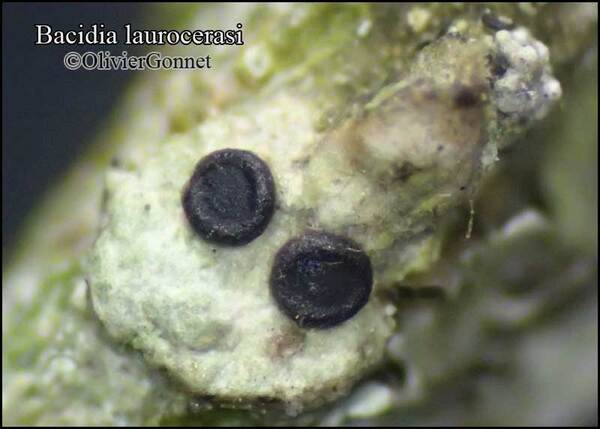
Courtesy: Olivier et Danièle Gonnet - Source: https://www.afl-lichenologie.fr/Photos_AFL/Photos_AFL_B/Bacidia_laurocerasi.htm
France, session AFL 2015 dans le Lot
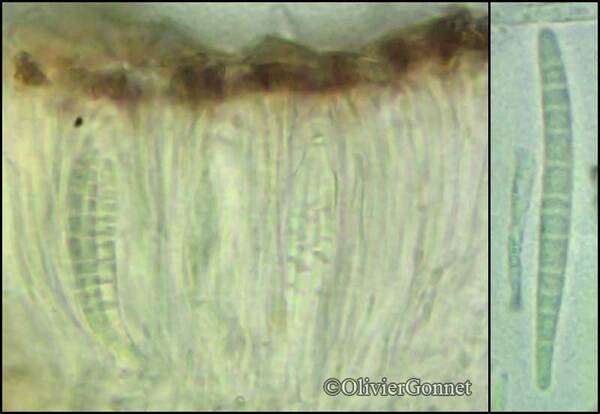
Courtesy: Olivier et Danièle Gonnet - Source: https://www.afl-lichenologie.fr/Photos_AFL/Photos_AFL_B/Bacidia_laurocerasi.htm
France, session AFL 2015 dans le Lot
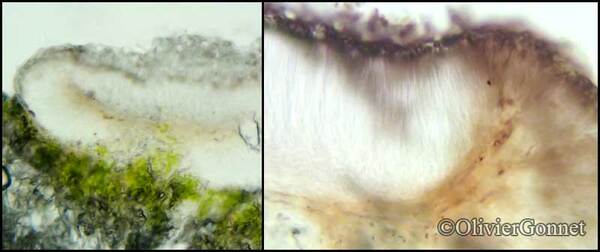
Courtesy: Olivier et Danièle Gonnet - Source: https://www.afl-lichenologie.fr/Photos_AFL/Photos_AFL_B/Bacidia_laurocerasi.htm
France, session AFL 2015 dans le Lot
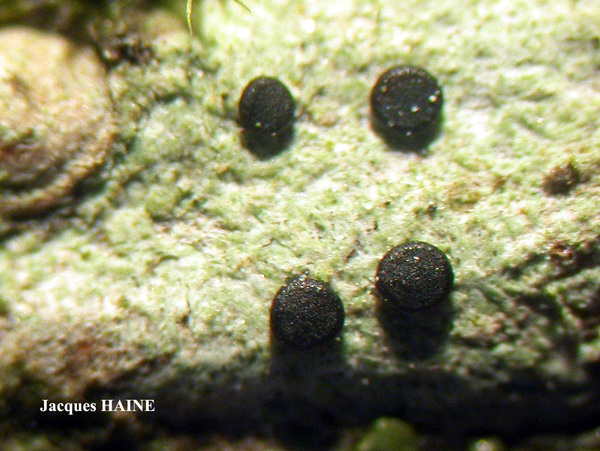
Jacques Haine - Source: http://www.lichensmaritimes.org/index.php?task=fiche&lichen=1098&lang=en
France, Huelgoat
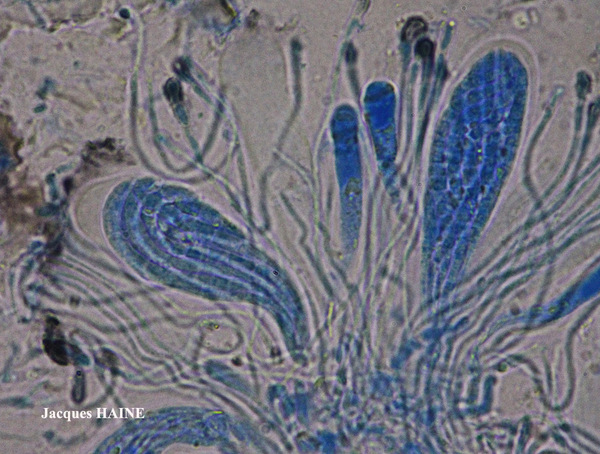
Jacques Haine - Source: http://www.lichensmaritimes.org/index.php?task=fiche&lichen=1098&lang=en
France, Huelgoat
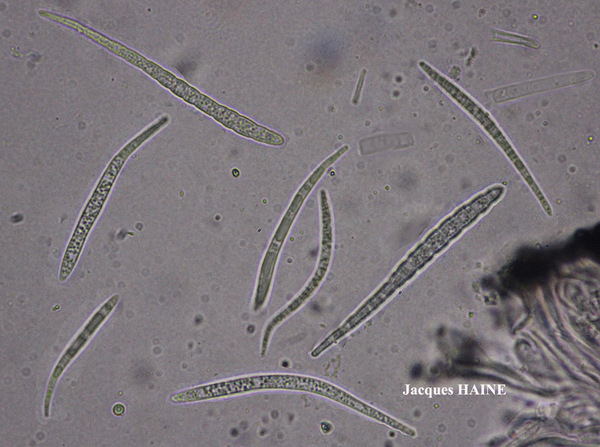
Jacques Haine - Source: http://www.lichensmaritimes.org/index.php?task=fiche&lichen=1098&lang=en
France, Huelgoat
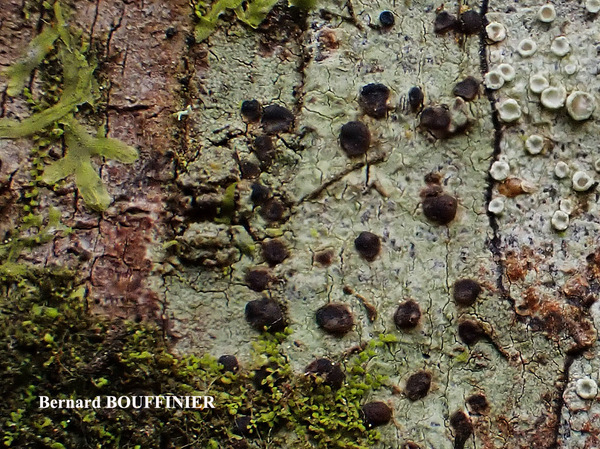
Bernard Bouffinier - Source: http://www.lichensmaritimes.org/index.php?task=fiche&lichen=879&lang=en
France, Roscanvel

Jacques Haine - Source: http://www.lichensmaritimes.org/index.php?task=fiche&lichen=879&lang=en
France, Roscanvel
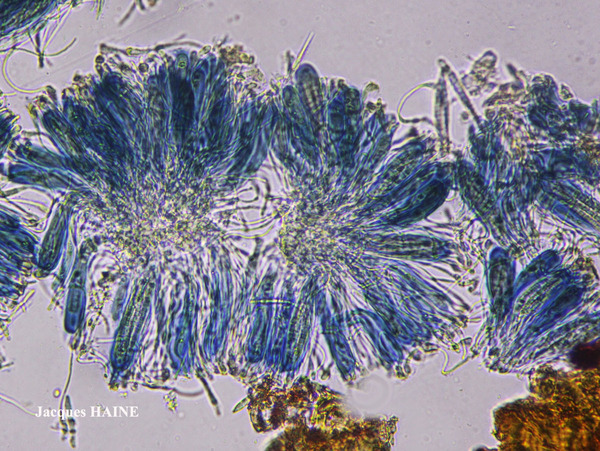
Jacques Haine - Source: http://www.lichensmaritimes.org/index.php?task=fiche&lichen=879&lang=en
France, Roscanvel
Growth form: Crustose
Substrata: bark
Photobiont: green algae other than Trentepohlia
Reproductive strategy: mainly sexual
Most common in areas with a humid-warm climate (e.g. most of Tyrrenian Italy)
Commonnes-rarity: (info)
Alpine belt: absent
Subalpine belt: absent
Oromediterranean belt: absent
Montane belt: rather rare
Submediterranean belt: very rare
Padanian area: absent
Humid submediterranean belt: rather rare
Humid mediterranean belt: rare
Dry mediterranean belt: absent

Predictive model
| Herbarium samples |


Felix Schumm – CC BY-SA 4.0
Image from: F. Schumm (2008) - Flechten Madeiras, der Kanaren und Azoren. Beck, OHG - ISBN: 978-3-00-023700-3


P.L. Nimis; Owner: Department of Life Sciences, University of Trieste
Herbarium: TSB (5247)
2001/11/22


Felix Schumm - CC BY-SA 4.0
Image from: F. Schumm (2008) - Flechten Madeiras, der Kanaren und Azoren. Beck, OHG - ISBN: 978-3-00-023700-3


Felix Schumm - CC BY-SA 4.0
Image from: F. Schumm (2008) - Flechten Madeiras, der Kanaren und Azoren. Beck, OHG - ISBN: 978-3-00-023700-3


Felix Schumm - CC BY-SA 4.0
Image from: F. Schumm (2008) - Flechten Madeiras, der Kanaren und Azoren. Beck, OHG - ISBN: 978-3-00-023700-3

Courtesy: Olivier et Danièle Gonnet - Source: https://www.afl-lichenologie.fr/Photos_AFL/Photos_AFL_B/Bacidia_laurocerasi.htm
France, session AFL 2015 dans le Lot

Courtesy: Olivier et Danièle Gonnet - Source: https://www.afl-lichenologie.fr/Photos_AFL/Photos_AFL_B/Bacidia_laurocerasi.htm
France, session AFL 2015 dans le Lot

Courtesy: Olivier et Danièle Gonnet - Source: https://www.afl-lichenologie.fr/Photos_AFL/Photos_AFL_B/Bacidia_laurocerasi.htm
France, session AFL 2015 dans le Lot

Courtesy: Olivier et Danièle Gonnet - Source: https://www.afl-lichenologie.fr/Photos_AFL/Photos_AFL_B/Bacidia_laurocerasi.htm
France, session AFL 2015 dans le Lot

Jacques Haine - Source: http://www.lichensmaritimes.org/index.php?task=fiche&lichen=1098&lang=en
France, Huelgoat

Jacques Haine - Source: http://www.lichensmaritimes.org/index.php?task=fiche&lichen=1098&lang=en
France, Huelgoat

Jacques Haine - Source: http://www.lichensmaritimes.org/index.php?task=fiche&lichen=1098&lang=en
France, Huelgoat

Bernard Bouffinier - Source: http://www.lichensmaritimes.org/index.php?task=fiche&lichen=879&lang=en
France, Roscanvel

Jacques Haine - Source: http://www.lichensmaritimes.org/index.php?task=fiche&lichen=879&lang=en
France, Roscanvel

 Index Fungorum
Index Fungorum
 GBIF
GBIF
